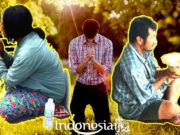Lohayong Fortress on the island of Flores is a historical building inherited from a Portuguese king named King Henricus XVII. The condition of this historic old building is just a 500-year-old boulder strewn on a cliff and hanging on the shoreline.
The condition of the Lohayong fort building is very poorly maintained and has suffered very severe damage due to the lack of concern from the local government and the surrounding community.
The Portuguese Catholic mission to the mainland of Flores and its surroundings originated from this fort. The fort is called “Port Henricus XVII”, a part of the religious pilgrimage “Semana Santa” in Larantuka, East Flores, East Nusa Tenggara. The fort is located about 20 meters from the shoreline at the western end of Lohayong Village, East Flores, with a height of about 50 meters above sea level (masl).
From the ruins of the fortress, it can be clearly seen that the ships and sailboats passing through the Solor Strait, between Solor Island and Adonara Island, East Flores. A bush-covered cannon of Portuguese heritage lay right on the edge of the cliff with its muzzle pointing toward the Solor Strait, which was used by ancient foreign ships.
The other cannons pointed east and west. In the western part of the fortress grew a banyan tree with hanging roots. Nie Kolin (81), an oral speaker of the history of Solor in Kawatung Village, said last week that until the 1850s, the Portuguese fortress area was called a city. This is because at that time only that area had sufficiently complete settlement facilities with a sea port which was still suitable for ships or boats to stop by.
Everything was built by the Portuguese. The port was used by Portuguese traders to transport sandalwood and agarwood from the island of Solor. Every month a boat lands in the harbor. The wood is obtained from the surrounding forest. The local population is still primitive, believing in mythical-magical things.
They did not easily accept the new teachings taught by Portuguese. They also did not dare to occupy the beach for fear of enemy attacks. At that time the lives of the tribes attacked each other. They build settlements on hills or heights so that they are not easily accessible to the enemy. Fishermen from outside In the 1870s, Lohayong was occupied by fishermen from outside.
They took advantage of a port abandoned by the Portuguese which still looked suitable for boat landings and catches. “This story was told by a father who got a story from his grandfather. Of course grandfather also got stories from his ancestors and so on. “There are seven or eight descendants of the Kolin tribe who have this story,” said Nie.
The indigenous people of Solor have clans (tribes), among others, Kolin, Herin, Hayon, Tukan, Kaha, and Kroon. Now, they spread throughout the mainland of Solor Island and outside Solor, such as Adonara Island, Lembata, and the mainland of Flores. The Kolin tribe as holders of words, teachings, spokespersons, and speakers of history. Koten as government leader and other tribes act as ordinary citizens. There is not much literature explaining the presence of the fort, including the year of construction, started by whom, and where the Portuguese got the sand and cement.
German anthropologist Paul Arndt (1886-1962), among other things, said that the fort was built from 1555 to 1603 under the power of the Portuguese king Henricus XVII so that it was also called “Port Henricus”. Inside the fort there is a catacomb with one bedroom unit which cannot be opened until today. The Catholic mission in Flores and Timor started from Solor so that in the old literature of the Catholic church it is mentioned “Mission Solor”.
This designation is reinforced by a number of old maps of islands on the eastern tip of Flores, called the Solor Islands and the Solor Strait. In fact, Solor is much smaller (three sub-districts) than Adonara Island (seven sub-districts) and Lembata Island (14 sub-districts).
East Flores Regional Secretary Anton Matutina said, around 1600, the Portuguese left the fort because of continued attacks from local residents, who were still primitive. The Portuguese then shifted to Larantuka and partly continued their journey to Sikka. Regarding the residents who are currently living in Lohayong, he said, they came later with the status of fishermen.
They took advantage of a dock that was built by the Portuguese and was still fit for use until the 1800s. Head of Lohayong II Village Thahir Kasim said the fort was 52 x 36 meters. Founded by the Portuguese around 1557, the aim was to protect themselves from attacks by local residents who had embraced Islam. “If the Dutch expelled the Portuguese, of course the people in Lohayong were Protestants, but in fact they adhered to Islam. “Who expelled the Portuguese from Lohayong, we will discuss with historians and a number of Catholic figures about this to find historical truth,” said Thahir.
Pilgrim “Semana Santa” Village Secretary Lohayong II Abdullah Imran said, every year, about 500 people visit the fort. They are mostly pilgrims “Semana Santa”, Good Friday in Larantuka, and foreign tourists. According to Lohayog Village regulations, visitors are charged IDR 25,000 per local visitor and IDR 100,000 per foreign visitor. However, Imran did not explain the benefits of this levy.
The condition of the fort itself was in a state of destruction, in ruins. Many fort researchers were amazed at the condition of the fort ruins. Even though the concrete mixture has been around 500 years ago, the concrete chunks are not easily destroyed. Sand and cement or a mixture of materials have very strong adhesives. “Researchers from Germany tried to chew the mixture to see if it tasted salty or not, but the taste was normal.
They even bring a little of the mixture to their home country for further research, “said Imran. Religious values Putra Solor who is also the Pastor of Baniona Parish, Fr Silvester Siku Pr, said that the Henricus fort in Lohayong is one of the Portuguese heritage which is believed to be a historical place that has religious values.
Inside the fort, about eight priests from the Dominican congregation were killed by natives. They are martyrs in preaching the Catholic religion. This fort is part of a series of spiritual pilgrimages “Semana Santa”, Good Friday in Larantuka, apart from the old church in Wure, Adonara. It was a pity that the fort was in an inconvenient location for pilgrims.
“To maintain Solor’s mission as the forerunner of Catholicism to grow and develop throughout the mainland of Flores to Timor Leste, it is better if a spiritual prayer garden is built in Solor. Pilgrims were directed to that place, ”said Silvester. Come on, obey health protocols and get other interesting information from indonesiar.com.
































